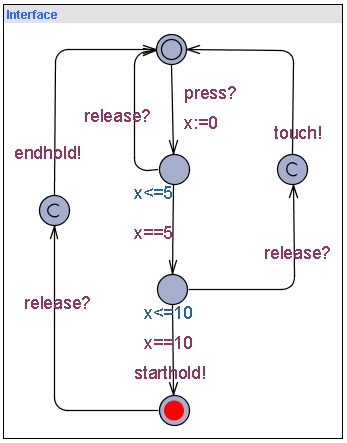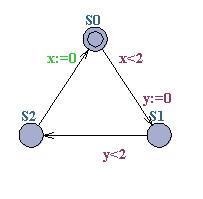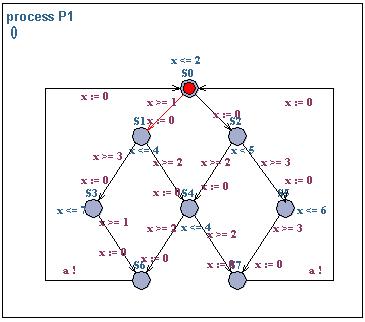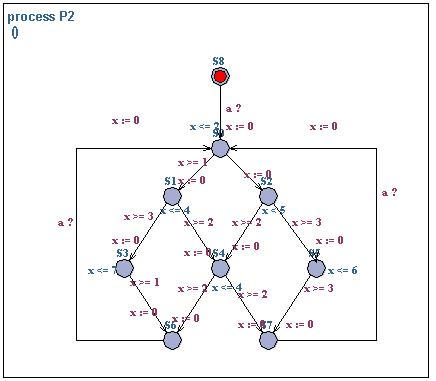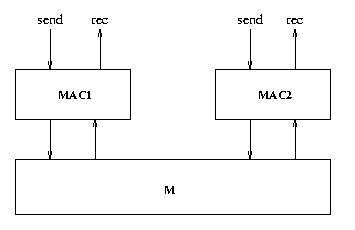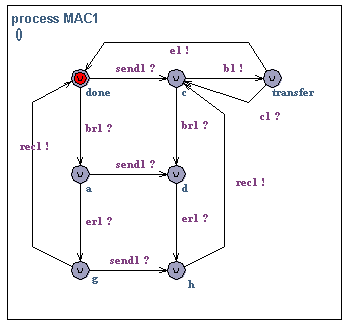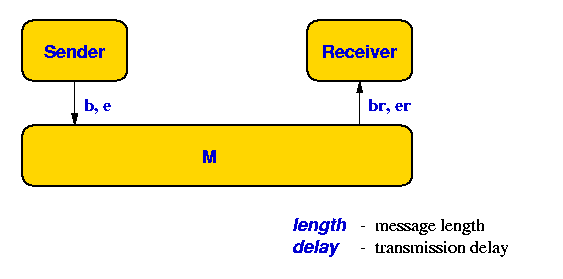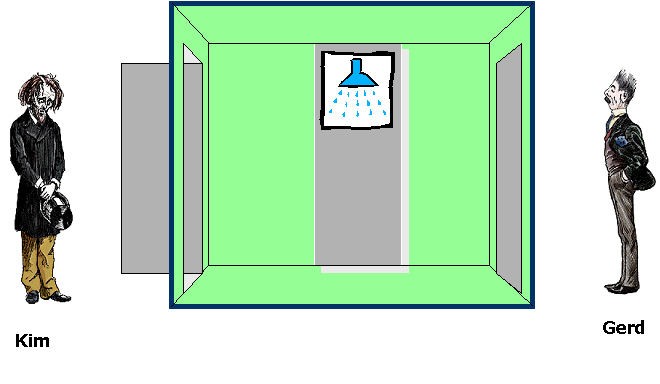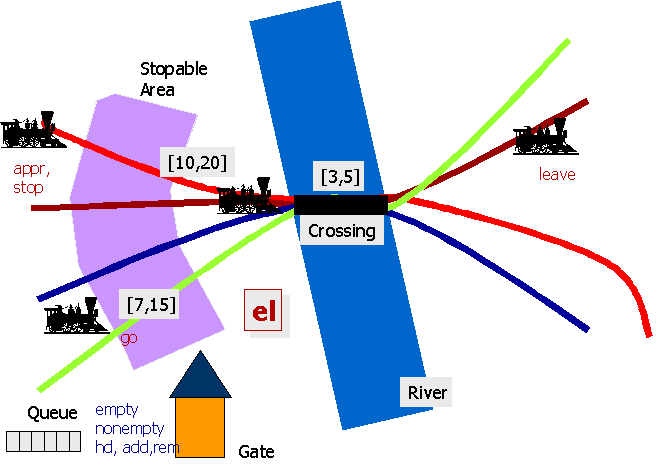Quantitative
Model Checking
Real-Time Systems
Exercises
- BRICK sorter
- Coffee machine
- Smart Light
- Protocol
- Veritication
Options
- Over approximation
- Active clock reduction
- Test automata
- Data Link Protocol
- Theory
- The CSMA/CD Protocol
- Protocol
- The CSMA/CD Protocol continued
- Gossiping Girls
- Reduction
- Solving constraint systems
- Representation of regions
- Druzba
- Train-Gate Debugging and
modification
- Jug Filling
- Rush Hour
- Crossing the River
- How much can we loose?
- How much can we reach?
- A simple vending machine
- An extended vending
machine
- The full vending machine.
- Job Shop Scheduling
- Leader Election
- Train-Gate: synthesize
safe and optimal control strategy
Exercise 1 (BRICK sorter)
Experiment with the BRICK Sorter model (.xml) in UPPAAL. Experiment with the model of the environment (including the number of bricks) to find out:
- under which circumstances the sorter operates correctly?, and
- under which circumstances the sorter misbehaves?
Use the functionalities of UPPAAL to explain what happens when the sorter misbehaves.
Exercise 2 (Coffee Machine)
In this exercise you are asked to design the control of a Machine (the control program) which will serve a coffee craving Person (the environment). As you can see above the person repeatedly (tries to) insert a coin, (tries to) extract coffee after which (s)he will make a publication. Between each action the person requires a suitable time-delay before being ready to participate in the next one.
The machine takes some time for brewing the coffee and will time-out if coffee has not been taken before a certain upper time-limit.
As a requirement we want the overall behaviour to ensure that the indicated Observer experiences a constant flow of publications from the system. In particular we want the Observer to complain if at any time more than 8 time-units elapses between two consecutive publications. Model the Machine and Observer in UPPAAL and analyse the behaviour of the system. Try to determine the maximum brewing time allowed by the Machine in order that the above requirement is met.
An initial sketch of a UPPAAL can be found here.
Exercise 3 (Smart Light)
Reconstruct a model of the Smart Light Switch (Intelligent Light Control) taking timing into account. Below you see (from the lecture) a timed automata model of the interface between the user and the control program. Complete the model by designing appropriate automata for the control program. Simulate the model and try to estimate the minimum time to take the light to its maximum intensity.
Exercise 4
Consider the above system, where a SENDER and a RECEIVER wants to communicate over a potential faulty communication line. In order to allow the SENDER to detect when communication succeeds, two (potentially faulty) communication media are used: one (K) for transmitting the message from SENDER go RECEIVER and one (L) for transmitting acknowledgements from the RECEIVER to the SENDER. We assume that the both media are one-place buffers. Also, we shall pay no attention to the actual message being communicated.
Use UPPAAL to model and analyse communication systems of the above type, where the media
- are lossy
- have delays
The desired behaviour of the overall system is that of a one-place buffer. Use UPPAAL to examine to what extent this behaviour is meet in the various scenarios above.
Exercise 5
(Verification Options)
Experiment with the various verification options of UPPAAL on Fischers Protocol(.xml, .q), The Soldiers Problem (.xml, .q) and the Gear Box Controller (.xml, .q). Estimate the verification times required and try to conclude on which options are to be prefered on which examples.
Exercise 6 (Over-Approximations)
Construct an example where use of the verification option 'Over-approximation' gives the wrong answer.
Try to make your example as small as possible.
Exercise 7
(Active Clock Reduction)
Consider the timed automaton below:
Calculate the active clocks for the three locations, S0, S1 and S2. Compute the reachable symbolic state-space of the timed automaton (using canonical DBM's for representing constraint systems) first without any reduction and afterwards with Active-clock reduction. Compare the number of constraints and symbolic states required to represent the reachable state-space in the two cases.
Exercise 8 (Test automata)
Consider the two timed automata P1 and P2 above. The automata are interacting over an urgent channel a. Use the testautomata or decoration technique for analysing bounded liveness properties of the form:
- whenever P1.S1 then P2.S0 within t timeunits,
- whenever P1.S0 then P2.S4 within t timeunits,
- whenever P1.S0 then P2.S0 will not occur before t timeunits.
You can find downloadable version of the system here (.xml.
Exercise 9 (Modeling)
In this exercise you are to model, validate and verify a simple data link protocol, where some unrealistic assumptions will be made in order to keep the exercise simple.
The protocol specification is as follows: there are a Sender, a Receiver and a Medium.
The medium can after reception of a message from the sender, do one of two things: either the message is delivered to the receiver, or it is lost. The loss of a message should be modeled by an internal transition (unlabelled transition in UPPAAL), since the loss itself does not constitute an observable event. When a message is lost a time-out in the sender will occur - model this time-out as a communication signal sent from the medium (in case of message loss) to the sender. In case of a time-out, the sender will retransmit the message. When the receiver gets a message an acknowledgment is sent to the sender. Assume that the acknowledgment is sent directly to the sender and not through any medium.
Task 1: Model the above protocol in UPPAAL, and validate using the simulator that it is functionally correct.
Redefine the protocol by modifying the receiver so that it reports to the layer above when a message is receive. Add a test process (to model the above layer) that receives the messages from the receiver. Modify the sender to receive messages from the layer above. Add another test process that generates messages to the sender (modeling the above layer).
Task 2: Validate that the functionality of the refined protocol is correct using the simulator.
Now modify the test environment so that the test sender increments a shared integer variable i whenever a message is sent. Modify the test receiver so that it decrements the variable i whenever a message is received.
Task 3: Validate the protocol and verify that the value of the variable i is always one or zero.
Task 4: What happens if the protocol is redefined in the following way: acknowledgments are not sent at all from the receiver to the sender? What happens if additionally the sender never expects acknowledgments? Validate, verify and describe in words the behavior of the resulting protocol.
Model the content of messages as (bounded) integer values and change the models of the protocol and the test environment consequently.
Task 5: Validate and afterwards verify, that the content of a message when sent equals the content of the message when received.
Exercise 10
(Theory)
JPK exercises 17, 18, 22.
Exercise 11 (Modeling, The CSMA/CD Protocol)
In this exercise you will study the Media Access Control (Mac) sub layer of the Carrier Sense, Multiple Access with Control Detection (CSMA/CD) communication protocol. The protocol specification consists of two MAC entities, MAC1 and MAC2, interconnected by a bi-directional medium M. The MAC entities are identical and can both transmit and receive messages over the medium. This means that collisions may occur on the medium (if the two MAC's transmit simultaneously). It is assumed that collisions will be detected in the medium and signaled to both MAC1 and MAC2.
Overview of the MAC sub layer.A model of the protocol is given in csma-cd-start.xml (the specification is taken from "Verifying a CSMA/CD Protocol with CCS" by Joachim Parrow. The specification uses the following synchronization actions to describe the protocol events:
- send - service provided by Mac which reacts by transmitting a message,
- rec - (receive) service provided by Mac, indicates that a message is ready to be received,
- b - (begin) Mac begins message transmission to M,
- e - (end) Mac terminates message transmission to M,
- br - (begin receive) M begins message delivery to Mac,
- er - (end receive) M terminates message delivery to Mac,
- c - (collision) Mac is notified that a collision has occurred on M.
Note that a message transmission is not modeled by a single action. Instead the start of a transmission and the end of a transmission are modeled by two separate actions (the actions b(r) and e(r)). This is needed as there may be collisions detected in the middle of a transmission. Note also that we use indexes on all actions as there are two identical MAC entities.
MAC1.Initially, MAC1 accepts a service call (send1?). The MAC initiates transmission (b1!), unless a message is in the process of being received. If the transmission is successfully terminated (e1!) new messages can be transmitted and the process is repeated. If a collision occurs (c1?) the MAC attempts re-transmission of the message. In all states (except when a message is being transmitted) the MAC is willing to start receiving. A message may be received (br1?) after which the MAC may not begin message transmission before the end of message (er1?) has been received and the MAC has signaled that the message is ready to be delivered (rec1!). However, the MAC may receive a send request (send1?) if there is not already another request waiting.
The medium M.Initially, the medium accepts transmission from one of the MAC's (b1? or b2?). We assume MAC1 (b1?) starts transmitting first (the case for b2? is symmetric). The medium is assumed to be "half-duplex" meaning that a full message must be transmitted (br2!, e1?, er2!) before the next message can be accepted. If the receiving MAC (i.e. MAC2) starts transmission (b2?) the medium interrupts the transmission and signals collision (c1!, c2!) to both MAC1 and MAC1 (in any order).
Task 1: Open the protocol specification in csma-cd-start.xml and add a test environment that "uses" the protocol. Validate that your system is functionally correct using UPPAAL's simulator.
Task 2: Check (by verification) if the system is correct in the sense that sent messages are received. How many messages can be in transfer at the same time? Is it 1, 2 or more messages?
The model of the MAC is slightly inaccurate. In reality, a MAC would be two processes: one sender performing the actions send!, b!, e!, c? and one receiver performing the actions rec!, br? and er?
Task 3: Refine the protocol by letting each MAC consist of two processes, a sender (S) and a receiver (R). The idea is to let S perform all "horizontal" transitions and R all "vertical" transitions. Replace MAC with S and R. Use UPPAAL to validate and verify that the protocol no longer is correct.
Task 4: Redefine the protocol again so that it works, while still keeping the S and R separate. This is a bit tricky. You may need to add some synchronization channels (or data variables) to achieve synchronization between S and R.
Exercise 12
(Modeling)
In this exercise you are asked to model a communication medium M, a Sender, and a Receiver. The sender sends messages of a fixed length length, which is the time between the beginning and the end of a message. The medium has a transmission delay delay, which is the time between the beginning (or end) of a message is sent and the beginning (or end) of a message is received. For example, if the beginning of a message is sent at time t, it will be received by the receiver at time t+delay.
Task 1: Model the system as a network of timed automata in UPPAAL. Assume length<delay. Model the beginning and end of each message. It is recommended to use integer constants in UPPAAL for the values length and delay.
Task 2: Validate the sytem in the simulator and find out what the total timed between "begin send" and "end receive" is.
Task 3: Modify the medium M to handle messages of length length>=delay.
Exercise 13 (Modeling: the CSMA/CD
Protocol continued)
In this exercise we use the model of the CDMA/CD protocol. You are asked to refine the model so that the sent messages have a fixed length of time length, and to refine the communication medium M to have a communication delay of time delay..
Task 1: Model/modify the system with the assumption length<delay.
Task 2: Verify that the system is correct in the sense that all sent messages are indeed received..
Task 3: Refine the medium to allow messages of length length>=delay.
Task 4: Verify that the refined system is correct in the sense that all sent messages are indeed received.
Exercise 14 (Gossiping Girls)
Model and analyze the following gossiping girls problem in UPPAAL. A number of girls initially know one distinct secret each. Each girl has access to a phone which can be used to call another girl to share their secrets. Each time two girls talk to each other they always exchange all secrets with each other (thus after the phone call they both know all secrets they knew together before the phone call). The girls can communicate only in pairs (no conference calls) but it is possible that different pairs of girls talk concurrently. For all of the tasks below you should consider the following three scenarios:
· Scenario 1: all girls may directly call any other girl, thus telephone network is a total graph.
· Scenario 2: only a single call in the entire network can take place at a time
· Scenario 3: the girls are organized in a linear chain (with a first and last girl) restricting calls to be made between neighboring persons.
Your tasks are as follows:
- Model the above three scenarios as a network of UPPAAL timed automata (using channels, clocks, timed automata templates, C-code, …)
- Use UPPAAL to find the minimal number of phone calls needed for four girls to know all secrets in each of the three scenarios.
- Refine your model so that each phone call lasts exactly 60 seconds (for simplicity this time duration is irrelevant of the number of exchanged secrets). Find the minimum time needed to solve the gossiping girls problem for four girls in each of the three scenarios.
- Experiment with the UPPAAL search options breath-first and depth-first search, random-depth-first search, upper and lower approximations, and with the diagnostic trace settings fastest and shortest. Try to solve the problem for five girls.
- Assume that the time of a call between two girls is uniformly distributed between 40 and 60 seconds. Also assume that a girl after having completed a call makes a new call after a 20 and 30 seconds accoriding to a uniform distriubution. Also assume that the call is made to a (uniformly) randomly choosen (other) girl. Using UPPAAL SMC to determine the expected time until all girls know all secrets. Also what is the probability that all girls know all secrets before 150, 200, 250, 300, 400 seconds.
Hint:
- Design a single template for all girls.
- For each girl, you may choose to remember the currently known secrets either in a local array of booleans or using an integer variable (use a binary encoding such that if a girl knows the secrets of e.g. girls 1 and 3 but does not know the secrets of girls 2 and 4, the value in the integer variable will be (0101) binary = 5; you might find useful the operation | for a bitwise OR).
Exercise 15
(Reduction)
This exercise will (hopefully) convince you that reachability checking in the UPPAAL-model is a hard problem indeed (NP-hard); if fact consider how you could use UPPAAL to analyse satisfiability of propositional logic formulas, i.e. formulas F build from propositional variables, b1, b2, b3,...... using boolean connectives (and, or, negation, ....). You may assume that F is in conjunctive normal form that is
F = C1 and C2 and C3 and ....... and Cn, where
Ci = Li1 or Li2 or Li3 or ......... or Lik, where
Lij is a variable bi or a negated variable ~biApply your idea for a construction to the formula:
(x or y or ~z or u) and (~x or y or z or ~u) and ( x or ~y or ~z) and (~x or y or ~u)
to see if the formula is satisfiable and if so to obtain a satisfying assignment to the boolean variables x, y, z and u.
Exercise 16
(Solving constraint systems)
The reachability algorithm of UPPAAL is based on efficient representation and manipulation of Difference Constraints Systems, i.e. linear equation systems between clock values where each constraint is of the simple form (xj - xj) <= bk.
In this exercise you should think about how to use UPPAAL to decide whether a given difference constraint system has solutions or not. Use your method to decide whether the following systems have solutions or not. In case there are solutions try to use UPPAAL to exhibit a single solution:
System 1: x1-x2<=1, x3-x1<=-1, x1-x4<=3, x2-x3<=5.
System 2: x1-x2<=1, x1-x4<=-4, x2-x3<=2, x2-x5<=7, x2-x6<=10, x4-x2<=2, x5-x1<=-1, x5-x4<=3, x6-x3<=-8.
Consider also how to use UPPAAL to check for two difference constraint systems D1 and D2 whether all solutions to D1 are also solutions to D2. Use your 'method' to check whether the constraint system 1 above is included in the following system 3:
System 3: x1-x3<=7, x3-x4<=2, x3-x2<=4.
Exercise 18
(Druzba Mutex Problem)
The Druzba example is based on a true story of the author to these exercises experienced during CONCUR02 in Brno. During this – otherwise extremely nice conference – accommodation was arranged in the local Druzba hostel. Rooms being nice, there was the unexpected surprise of sharing the shower with the neighbor (causing some screaming in at least one occasion). Being at THE concurrency conference a lot of possible solutions for how to obtain MUTEX in the shower were discussed. Your job is to find a good solution.
.
In the intial solution model the two users of the showers may at any moment in time make a go for the shower (will take between 3 and 5 minutes in the corridor). The actual use of the shower will take between 7 and 10 minutes. Obviously this initial model is erroneous as can be seen by checking the properties of the the query-file. Assume that the bathroom has a light which can be checked and switched on (or off) before entering the bathroom. Show how this can be used to correct the model and supplement the query-file so that you obtain a satisfactory system (and verifiable so).
Exercise 19
(Train-Gate Error Correction and Modification)
The following contains an erroneous version of the train-gate example. Here is the appropriate query-file.
· Use UPPAAL (simulation, verification) to pin-point and explain the error(s).
· Having corrected the errors what is the minimum time one can guarantee between a train requesting access to the crossing and actually getting there?
· Assume that we want to give the trains priority according to their id. Change the scheduling-policy of the Gate accordingly. What can be said about the correctness and performance of the system now? (You may find a proposed solution here).
· Change the model so that a train can only make a new approach after some time MIN after having left the crossing. What is the minimum value of MIN that will ensure that no train is starved even under fixed priorities? For each train what is the minimum time one can guarantee between a train id is attempting to approach the crossing and actually leaving it?
Exercise 20
(Jug Filling)
Consider the one-player Jug
game illustrated below. In this instance, two
jugs are given with capacities 5 and 3
respectively. Initially, the two jugs are empty. Now
legal actions/rules on the jugs are fill (we assume an infinite capacity
tap by which we may fill any jug to the rim), empty (we may at any time
empty the complete content of a jug on the floor), and pour the content
of one jug into the other (of course stopping the pouring if and when the rim
is reached). Given this initial configuration, and legal rules, we
want to figure out whether it is possible to reach a situation where the
content of one jug is exactly 1. Make a
scalable model of the Jug game in UPPAAL (i.e. allowing for arbitrary numbers
of jugs with arbitrary capacity) and use it to find solutions bringing the
above instance into a final configuration where the large jug contains 2 units, 3 units, 4 units, and where the large jug contains
3 units and the small jug contains 2
units.
Exercise 21
(Rush Hour)
In this exercise you are asked to model a solitair game and solve use UPPAAL to solve the puzzle. The
game is simple. You have a 6x6 board like shown on the picture below. On the board you find a number of cars of different size (personal
vehicles and trucks). The goal of the game is to move the cars by driving
forward and backwards in such a way that the red car can leave the board at the
exit on the right side of the board. The cars cannot turn!


Task 1: Make a model of the game in UPPAAL.
Task 2: Use your model to solve the two puzzles shown in he second picture. What is the shortest
number of steps/moves needed to solve the puzzle?
Task 3: Extend your model with timing constraint. Assume that
it takes a different amount of time to move the cars, e.g. 2 time units for the
small ones and 3 for the trucks (you can also choose to give each car its own
time). Try to experiment with different assumptions as to the number of
hands/drivers, i.e. how many cars can move at the same time.
Task 4: Use Uppaal to find the fastest way of solving the puzzle (not
measured in computation time, but in time it take to move all the cars). Tip:
Use Uppaals diagnostic trace feature and ask for the
fastest trace.
For the keenest: you may
want to deal with the more challenging RAILROAD Rush Hour, which is on a 7x7
boards and with 2x2 blockers that can move bort
horizontal and vertical (see figure below):
Exercise 22
(Crossing the River)
Help a familly to cross a river according to
the following constraints:
- Max 2 persons on the boat,
- Mom not alone with boys,
- Dad ont alone with
girls,
- Thief not alone with family,
- Only police officer, dad and mom can handle the
boat.

Task 1: Make an Uppaal model of it
and generate a feasible schedule.
Task 2: Add temporal constraints (e.g. each adult take a
certain time to cross the river with the boat) and try to find the quickest
possible schedule.
Task 3: Try other parameters and constraints for this game.
Determine what is the feasibility limit depending on the number of boys, girls,
prisonners.
Exercise 23
(How much can we loose)
Consider the following algorithm containing two parallel processes both
incrementing a common variable:
int n=0;
(n := n + 1 || n := n + 1)
In case the underlying computational model execute n:=n+1
as an atomic operation the post condition is that n=2. But in case n:=n+1 is executed as a number of atomic operations the post
condition becomes 1 ≤ n ≤ 2.
Now we generalize the problem with respect to the number of increments
done by each processor. Consider the following algorithm in which n:=n+1 is a non atomic operation, i.e. n:=n+1 is composed of the
following sequence of three atomic updates: r:=n; r:=r+1;
n:=r where r is a register local for the
given parallel process:
const int k=…; int n=0;
Process P
do
n := n+1
k times
end P
( P || P )
For k=1, this program is equivalent to program
1. Obviously (why?) the final value of n can not exceed 2*k. Intuition leads us to
believe that k is the smallest possible final value of n! However, this intution is wrong. Use UPPAAL to model the above
scenario (e.g. with k=10) and use model-checking to
find the smallest possible final value of n. Try to increase the
number of processes (e.g. consider ( P||P||P )).
Exercise 24
(How much can we reach)
Again we are considering the paralle execution of two, simple (and identical) sequential
programs:
const int n=1;
Process P
do
n :=
n+n
forever
( P || P )
Given that n:=n+n was atomic the possible
values of n during execution would be (all) powers of 2. However,
consider the situation when the update n:=n+n is
carried out as the following sequence of three atomic updates:
r:=n; r:=r+n; n:=r. Now the question as to which values n may achieve
during execution is no longer obvious. Model the above scenario in UPPAAL
and try to figure out whether (and how) n can achieve the values 2, 3, 8, 9, and 23. Which (and why) values can n achieve?
Exercise 25
(Simple Vending Machine)
![]() In this exercise you are required to model a (very) simplified
vending machine for beverage cans. The vending machine is supposed to
sell cans (containing some interesting substance) to customers. In this
simplest version, the machine only sells a single kind of cans where a can cost
one single unit (of the currency of your choice). We also assume that the
vending machine has an unlimited number of available cans. Purchasing a
can is usually performed as follows:
In this exercise you are required to model a (very) simplified
vending machine for beverage cans. The vending machine is supposed to
sell cans (containing some interesting substance) to customers. In this
simplest version, the machine only sells a single kind of cans where a can cost
one single unit (of the currency of your choice). We also assume that the
vending machine has an unlimited number of available cans. Purchasing a
can is usually performed as follows:
1.
The customer inserts a coin into the machine
2.
The customer may now either
- request a can, or
- cancel
3.
Depending on the order of the customer
the vending machine should either provide a can or return the coin.
Model in UPPAAL the vending machine. Also make models of various
types of customers including a random customer (may at any given moment
non-deterministically try to insert a new coin, cancel an order,
...etc), a fair customer (behaving as intended
by the machine), a non-thirsty user (always cancelling after insertion of
coin). Validate the various configurations (machine and a particular
customer) by simulation. Check for (absence) of deadlock in your model.
Try to verify that cans reqeusted will
be delivered, and cancellations are objeyed.
What happens if the configuration involves multiple users (possibly of
different type)?
Exercise 26
(Extended Vending Machine)
![]() Extend the model of the vending machine from the previous exercise so
that the price of a can is 5 units (or coins). Also
change the behaviour of the customers so that mulitple
coins may be inserted before reqeusting a can is
attempted -- both the machine and the user should have their own local variable
(pendingCoins) for recording the credit of the
customer. When a can is requested the surplus of
coins should be given back to the customer. To make matters simpler you
may assume that the user has a limited number of coins (say 10).
Extend the model of the vending machine from the previous exercise so
that the price of a can is 5 units (or coins). Also
change the behaviour of the customers so that mulitple
coins may be inserted before reqeusting a can is
attempted -- both the machine and the user should have their own local variable
(pendingCoins) for recording the credit of the
customer. When a can is requested the surplus of
coins should be given back to the customer. To make matters simpler you
may assume that the user has a limited number of coins (say 10).
Try to establish the following properties either by
simulation or verification:
1.
If the pending amount of money is sufficient (=5) and
(only) the button "requestCan"
is pressed then a can will be given out.
2.
A can is only delivered if the pending amount of money
is sufficient (=5)
3.
As soon as a can is delivered,
the change is given to the cusotomer.
4.
The machine does not loose or produce money.
5.
The amount of pending coins in non-negative.
6.
If cash is pending and (only) the "cancel"
button is pressed then the machine will output all pending coins and no can.
Exercise 27 (Full Vending Machine)
![]() In this final
(and full) version of the vending machine the machine is supposed to have a
finite capacity (e.g. can only have 5 cans at any
given moment). Also, the machine should -- using
local variables -- keep track of the number of cans delivered and coins earned
since last inventory. During inventory and Auditor removes
all earned coins (presumably taking them to a bank) and fill the machine completely
with cans (e.g. 5). Reconsider validations of the properties of the
previous exercise. In addition validate (by
simulation or verification) the additional properties:
In this final
(and full) version of the vending machine the machine is supposed to have a
finite capacity (e.g. can only have 5 cans at any
given moment). Also, the machine should -- using
local variables -- keep track of the number of cans delivered and coins earned
since last inventory. During inventory and Auditor removes
all earned coins (presumably taking them to a bank) and fill the machine completely
with cans (e.g. 5). Reconsider validations of the properties of the
previous exercise. In addition validate (by
simulation or verification) the additional properties:
1.
The amount of earned coins is non-negative.
2.
No more than 5 cans can be
delivered in a row without inventory.
3.
After delivering five cans without inventory, no more
cash is accepted
4.
The amount of earned/store coins is five times the
number of delivered cans (since the last inventory).
Exercise 28 (Job shop scheduling)
Jobshop
scheduling problems involves a number of jobs -- J0,..,Jn
-- to be treated by a number of machines -- M0,..Mk. In this particular
variant each job Ji needs to be treated exactly once by each machine and in a
particular order and for a particular time-duration. The problem is to
find an time-assignment indicating at which time Ji
should be treated by Mj in a way such that the prefered sequence of Ji is respected and so that a machine Mj is never used by more than one job at a time. The
challenge is to identify the minimum Makespan, i.e.
time-assignment which the minimal total duration.
|
Sport |
Economy |
Local News |
Comic Stip |
|
|
Kim |
2. 5 min |
4. 1 min |
3. 3 min |
1. 10 min |
|
Jüri |
1. 10 min |
2. 20 min |
3. 1 min |
4. 1 min |
|
Jan |
4. 1 min |
1. 13 min |
3. 11 min |
2. 11 min |
|
Wang |
1. 1 min |
2. 1 min |
3. 1 min |
4. 1 min |
Consider the particular Jobshop scheduling problem
above, where 4 persons (Kim, Juri, Wang and Jan = the
Jobs) needs to read 4 sections (the Machines) of a single news
paper. Make a UPPAAL model of this instance of the jobshop. You may want use the following UPPAAL skeleton
model containing a generic Job-template (see here)
or full model (see here).
Use the model checking engine of UPPAAL to determine
the minimum make-span, i.e. the minimum time until all persons has completed
reading all sections. Identify also the minimum time for Kim to finish reading
his sections, and the minimum time for Wang to finish his sections. What is the minimum time to have both Kim and
Jan finishing reading their sections. Try to
illustrate using informative Gantt charts.
Use
UPPAAL CORA to determine the schedule that minimizes the total accumulated
waiting-time for the persons (i.e. the time where a person is not reading).
Assume that the cost of having persons waiting for a next section varies (say
cost per minute 1, 2, 3 and 4). Now use UPPAAL CORA to find the cost-optimal
schedule.
|
Sport |
Economy |
Local News |
Comic Stip |
|
|
Kim |
2. 3-6 min |
4. 1-5 min |
3. 3-6 min |
1. 10-11 min |
|
Jüri |
1. 8-10 min |
2. 20-23 min |
3. 1-6 min |
4. 1-12 min |
|
Jan |
4. 1-3 min |
1. 13-20 min |
3. 11-23 min |
2. 11-13 min |
|
Wang |
1. 1-3 min |
2. 1-5 min |
3. 1-3 min |
4. 1-4 min |
Consider
the Jobshop scheduling problem with the time required
for a given person to read a certain being given by a
uniform distribution over a given interval (see table above). Modify the
Job-shop scheduling model that you made in the previous part of this exercise
(see the skeleton here)
to take these timing intervals into account (in the template). Add exponential
rates for each person (proposed rates are: Kim: 5,
Juri: 2, Jan: 6, Wang: 1) defining the distributions by which the person will
start to read a section. Now use the SMC
engine to determine the following interesting quantities. What is the probability that all persons will
have completed his reading before time 200 – have a look at the cumulative
probability distributions. What is the
probability that Kim finishes before Wang within 200 minutes? What is the probability that Wang finishes
before Kim within 200 minutes? Use
hypothesis testing to check for each of these unknown probabilities whether it
is larger than 0.5? Also
compare these two probabilities?
Finally equip the model with local clocks for
each person in order to estimate the individual expected completion times. Also
add stop-watches for each person in order to estimate the expected total
waiting time (that is time when a person is NOT reading)
Optional You may
want to use UPPAAL TIGA to a reformulation of the above problem as a timed
game, where the reading times are modeled as uncontrollable transitions. Use TIGA to synthesis a time-optimal
strategy.
Exercise 29 (Leader Election)
We consider leader election in a ring topology.
We assume that each node of the ring has a unique identifier
and a unique priority. The object of the algorithm is to have
all nodes identifying the (node with the) maximum priority (above this is node
2 which has priority 5). We consider the
LCR algorithm (Lann, Chang and Roberts), where each
process sends its priority around the ring.
When a process receives an incoming priority, it compares that priority
to its own, it keeps passing the priority; if it is less than its own, it
discards the incoming priority; if it is equal to its own, the
process declares itself the leader.
Model the behavior of a process as a timed
automaton (template) in UPPAAL. In
modelling a process should at all time be able to
receive priorities
from its predecessor node. Also a process must
repeatedly output the priority of the currently believed leader to the
successor node with a maximum time separation of Delay.
Q1. Simulate
your model to ensure that it corresponds to the informally given explanation
above.
Q2. Verify that a leader eventually be elected (what
does that mean)? What is the maximum amount of time before the leader is elected?
Q3. What is the maximum number of priorities sent in
the network before the leader is elected?
Q4. What is the expected time before a leader is elected?
Q5. What is the expected number of priorities sent before the
leader is elected?
Q6. Modify the model so that priorities are only sent (before MaxD
time-units) with a certain probability (say 70%). Investigate the effect of this on the
properties (e.g. those above) of the protocol.
Q7. Investigate what happens if a node completely fails
(e.g. by the transmission probability being 0%).
Exercise 30 (Train Gate revisited)
You will
find a (partial) STRATEGO version of the Train Gate here. Please consider the following questions:
Q1. In the query given we synthesize a strategy Safe that guarantees that the crossing
is every only occupied by at most one train.
What is the expected time (within a bound of 200 minutes) until Train(0) is in the crossing under Safe? What is the expected time (within a bound of 200 minutes)
until Train(1) and Train(2) is in the crossing under Safe?
Q2. Synthesize a strategy GoFast that minimizes the
expected time (within a bound of 200 minutes) until Train(0)
is in the crossing? What is the expected time provided by GoFast for the various
trains? Is GoFast safe?
Q3. Synthesize GoFastSafe as a substrategy of Safe that minimizes
the expected time (within a bound of 200 minutes) until Train(0) is in the
crossing. What is the
expected time provided by GoFastSafe for
the various trains?
Q4. Reconsider Q1, Q2 and Q3 above but with the purpose
of maximizing the number of trains passing the crossing within a given time
bound (say 1000 minutes).
Q5. Reconsider Q1, Q2 and Q3 but with the purpose of
minimizing the total accumulated stoppage time of trains with a given time
bound (say 1000 minutes).

